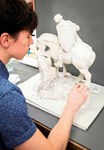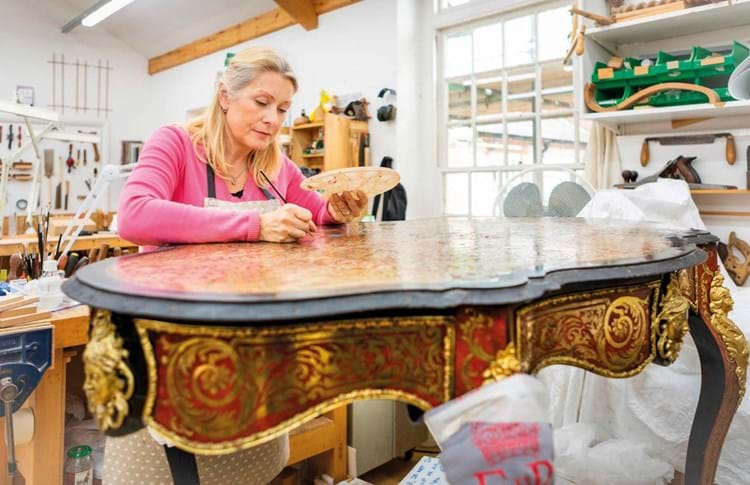
Thousands of viewers have tuned into watch how a rusty and broken Victorian weathervane and an antique chest from Oman are painstakingly restored in a barn in the Sussex countryside.
Thousands more have watched how an Old Master painting can come to life under a cotton bud and head torch in a darkened conservator’s studio in Mayfair.
Turn on your TV and it is likely you could be inviting restorers and conservators into your home through popular shows including BBC’s The Repair Shop and Britain’s Lost Masterpieces.
But just as the skill and craft of restoration and conservation entered the limelight, there have been fears the availability of training and jobs could be dwindling – particularly during and after the current coronavirus pandemic.
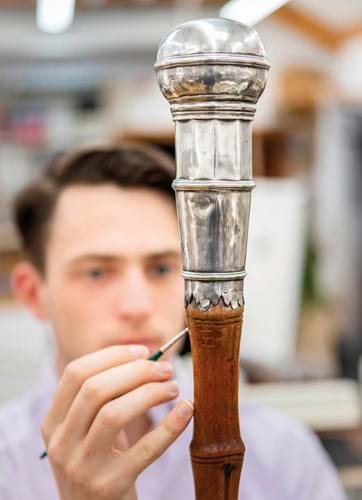
A student at West Dean College of Arts and Conservation. Photo: Christopher Ison/West Dean College of Arts and Conservation.
Screen scene
Some in the antiques trade have also been concerned that television programmes give the general public the erroneous impression that such complex work can be undertaken easily, at no notice and at no cost.
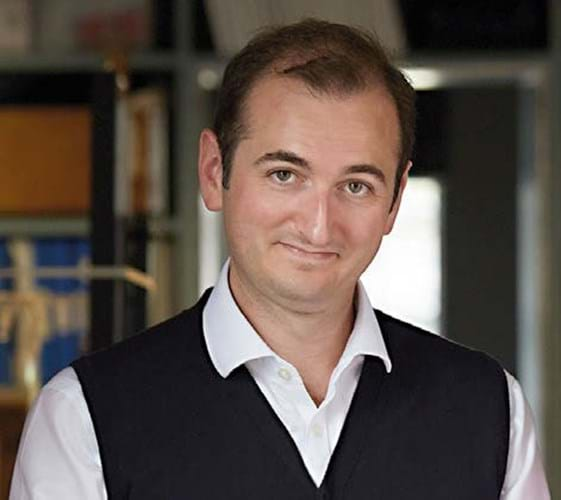
Bendor Grosvenor. Photo: BBC Pictures.
Dealer and Britain’s Lost Masterpieces presenter Bendor Grosvenor says: “There is a danger that programmes which show multiple restorations in the space of one hour make the process look easier than it really is.
“However, from what I’ve seen on The Repair Shop, they emphasise all the skill and training that goes into the process. In Britain’s Lost Masterpieces we show how our restorer, Simon Gillespie, can take months to get to grips with a picture.”
Fewer courses exist than before in the area of restoration and it is not a career open to many because of the costs involved in starting out.
Grosvenor adds: “I often hear from people who want to train as restorers, but the problem is the lack of opportunity to do so. It’s a long process, which isn’t cheap. We see the same pressures on those who want to be curators; the entry salaries are low, and the qualification thresholds are high.”
Some firms are willing to take on graduates, however. Conservation and restoration firm Plowden & Smith managing director Camilla Hughes-Hunt says: “There may be fewer UK institutions offering undergraduate degrees in conservation, but thankfully there is still a wide variety of courses out there that provide excellent training to aspiring conservator-restorers.
“Every year we are delighted by the high level of internship requests we receive from young conservators, not just from the UK but from all over Europe. As part of our commitment to supporting this next generation of talent, we always try to accommodate as many of them as our business allows.”
Appetite for information
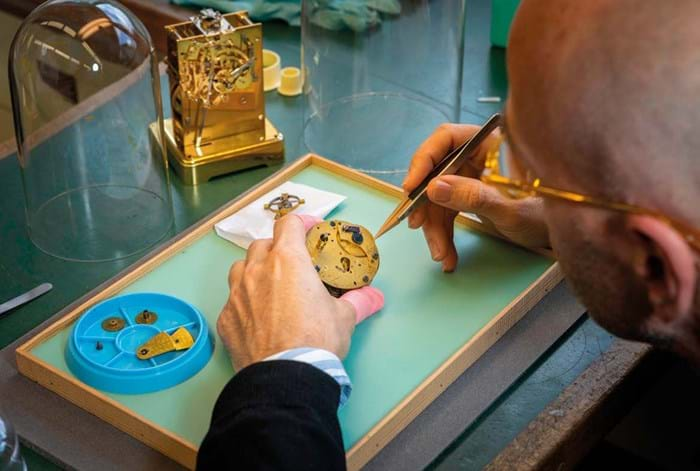
A West Dean College student working on a clock. Photo: Christopher Ison/West Dean College of Arts and Conservation.
One institution still focused on the sector is West Dean College of Arts and Conservation in Chichester which recently merged with KLC School of Design in London (see separate story).
KLC will join The Edward James Foundation, which operates West Dean College, with the aim of combining operations from August.
Lizzie Neville, head of school of conservation at West Dean, says: “There’s undoubtedly been disruption to the heritage sector due to the impact of closures of museums, libraries and archives during the lockdowns.
“But looking at the sector generally, after a year of sitting at a screen there seems to be a real appetite from the public and students to find out about how things were made, what they were used for and who they were owned by.”

Students at West Dean College of Arts and Conservation. Photo: Christopher Ison/West Dean College of Arts and Conservation.
Top-end spending
Commercially, firms have reported demand from owners of artworks and antiques, even if museums’ budgets may be under stress and strain.
Hughes-Hunt adds: “There are certainly plenty of very rich individuals who invest in art for pleasure or as an asset class so I suspect that conservation at the very top end will remain unaffected.
“It may in fact increase as we see more demand from collectors in places like Hong Kong and the Middle East where there are plenty of wealthy collectors, but very few local conservators with the skill needed to treat some of the more complex issues we see with Modern and Contemporary art.
“At the middle level, I am reasonably confident that demand will stay strong, a result of so many more people having far greater awareness that it is possible to restore things, and people taking advantage of not being able to spend money on holidays, or not having to commute into work, to spend a bit extra on things like art and restoration.”

Cleaning a frame at West Dean College of Arts and Conservation. Photo: Christopher Ison/West Dean College of Arts and Conservation.
Good prospects
And the trade is still keeping the sector in business too. Grosvenor admits: “Given the number of pictures I have at the moment that need attention, the prospects for restorers are still very good!
“There’s a good saying in the art trade that cleaning is the friend of a good picture. With a dirty picture you often think that it’s going to improve with cleaning – and with a good picture it will – but a bad picture can lose its mystery, and, once cleaned, look more like a bad picture than ever.
“So the trick is to choose which pictures to clean very carefully…”
Picture restoration had a patchy reputation in the past and it is often today’s restorers who are still picking up the pieces.
Grosvenor adds: “Picture restoration has come a long way since it was left to the cares of the housemaid with a sponge and bucket.
“In fact, in the history of western art, no single group of people has done more damage to art than those charged with looking after it; what passed for good restoration in the past often left catastrophic results, with fads like transferring panel pictures to canvas.
“If anything, conservation has now gone a little far in the other direction; being too cautious with cleaning pictures, with the result being that ‘dirty’ works are left in storage, unseen and unloved.”
History lesson
Conservator Simon Gillespie (also see Q&A in this feature) agrees: “In the past, having one’s art cleaned would probably entail a local craftsman or, if you’re lucky, a painter ‘washing’ the painting and if anything was missing then ‘retouched’.
“This often resulted in pictures being harshly cleaned, where the finest thin surface layer of paint would be damaged, which can be the make or break of a picture being in good condition or not. Then the clumsy covering over of the damage with a large brush often resulted in large areas of a painting being repainted. It’s happened throughout history.
“With the value and ease of transport of works of art, pictures get damaged and the trading in pictures also means they are handled and interfered with more often.
“Gone are the days when a family mansion would be passed from generation to generation and be sold with its contents in place, and the benign neglect would leave paintings untouched on the same wall for generations. Sometimes the best condition pictures have come from such windswept castles in remote places.
“Although there are still untrained practitioners causing damage to paintings, the training of conservators these days is very good and the treatment options so varied. Technology has leapt on, meaning that cleaning a painting these days is quite different from two generations ago.”



